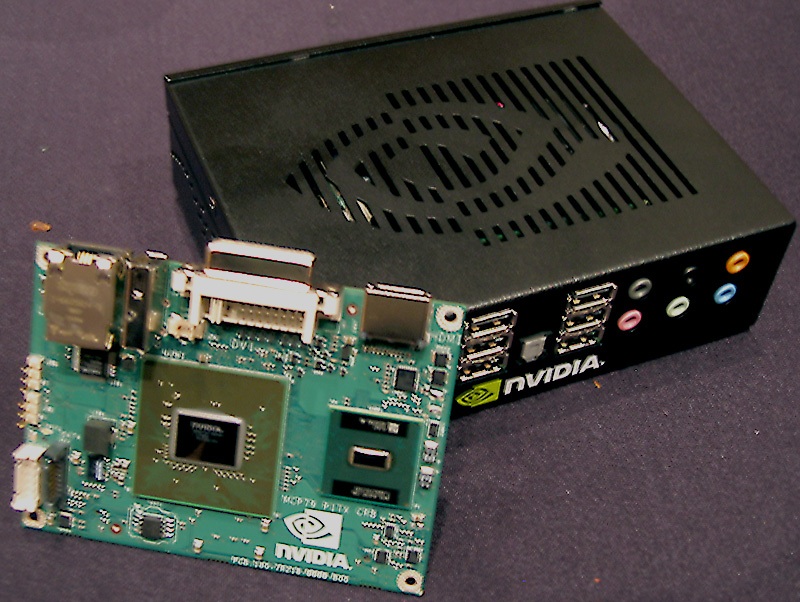CES '09: Nvidia Shows Off Ion
Some things have to be seen to be believed. At first, we weren’t particularly blown away by the idea of Nvidia’s Ion platform, which Steve reported on last month. And although that piece included pictures of the Ion motherboard and a mockup of what an Ion platform might look like, we got our first chance to see the little setup in person and in action tonight at CES in Las Vegas.
We’ve already had plenty of experience with Atom and it hasn't been pretty thus far. Completely incapable of delivering a compelling Vista experience, we were bearish about the single-core Atom 230’s potential on the desktop, emphasizing its mobile target audience.
The dual-core Atom 330 in Nvidia’s design might change that, though. While it runs at the same 1.6 GHz on a 533 MHz front side bus, the Atom 330 has two times the execution resources and L2 cache (1MB total on Intel’s 45nm lithography node) looks to catapult the little Ion into the realm of desktop feasibility. According to Nvidia, it has its eye on the nettop market with Ion, and might even nudge into the laptop space, vying with Centrino in environments where graphics performance and cost are principle concerns. Tegra remains the company’s ultra-mobile architecture of choice.
More important than the host processor, at least in Nvidia’s mind, is the GeForce 9400M chipset soldered onto the index card-sized motherboard, which is not only vastly superior given the power profile of Intel’s 945GC, but it's significantly more capable when it comes to 3D. For one reason or another, Nvidia is focusing specifically on Call of Duty 4 in its projections, claiming playable performance around the 30 fps range (we’re assuming this is at 800x600). And as we already know from previewing GeForce 9300, the core logic is able to deliver solid video playback over HDMI as well.
How much might you expect to pay for an Ion-based system? Roughly $400, Nvidia says. We asked if there were any plans to launch a retail box similar to the mockup on display. Interestingly, it doesn’t look like the company is going to be getting Atom chips from Intel, which wants to sell the lightweight CPU with its 945GC clunker of a platform instead, though Intel has denied in the past that it would refrain from selling the chips on its own.
In our original Ion report, we said availability of the hardware would likely start some time in the first half of 2009. However, Nvidia indicated to us that it’d be able to begin sampling by the end of January, suggesting the hardware is pretty much ready to go. You can expect a more in-depth look at Ion as soon as Nvidia is ready to preview the platform.
Get Tom's Hardware's best news and in-depth reviews, straight to your inbox.
-
Shadow703793 ReplyTegra remains the company’s ultra-mobile architecture of choice.
Too bad it's an ARM CPU. -
Awesome!Reply
I've always been a huge fan of NVIDIA ( Except the little faulty GPU incident that happened last year) I expect great things from them and I think the Ion may be a fair entry level PC. Heck it may even force ATI to produce a similar project ( AMD said they were NOT getting into the nettop CPU market, but nothing about the nettop graphics market ;) ) -
Keep us updated!Reply
Atom 2Core on this platform could possibly be the best desktop for low power requirements!
Pitty it does not come with PCIE 16x or pcie 2 (so far).
probably an excellent machine for Windows 7! -
cabose369 see nettops to me don't make much sense.Reply
For example... this nettop will cost $400USD.
For $399CDN you can get an Acer (crap I know but using it as an example) desktop with a Pentium Dual Core processor (which will be A LOT faster than an Atom processor) 2GB Memory, 320GB Hard Drive, DVD Burner. All you need to do then is spend $50 or so on an Nvidia 8400/9400 or 8500/9500GT graphics card and for the same price as this nettop have a WAYYY better machine that is much faster and can do a lot more. -
shachar2 you might want to write a small paragraph review on the technology/atom and what it means, not everybody is following you 24/7 and knows what you're talking about bozo!Reply

